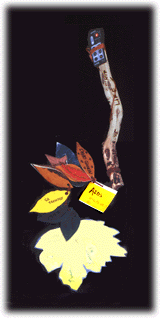


"Art allows thoughts, feelings, and memories to surface so that deep concerns can be acknowledged and expressed. In Remembrance, people can express their feelings by videotaping personal stories about how HIV and AIDS have affected their lives. You may ask exhibit staff to help you set up the camera and use the talking stick inside the booth to record your own story. You may also view the Remembrance collection in the viewing area.
"The talking stick that is part of this exhibit was inspired by those used by traditional storytellers in Africa. I made it from a stick I found in my backyard. I burned words into it that I felt resonated with feelings that come up when talking about HIV and AIDS.
"My own experiences have been deeply affected by the men I worked with while I was an artist-in-residence in a prison. I wanted these men to become part of Remembrance so they would not be forgotten. The poem inscribed on the talking stick was written by an inmate; the leaves attached to the stick commemorate some of the men who have recently died.
"The storytelling itself is a spiritual experience; some people feel a profound sense of happiness and peace after recording their emotions. The outcome doesn't change, but the creative process allows people to experience themselves and their lives as fully as possible."
--Wendy Clarke

Traditional storytellers in Africa still use talking sticks while telling stories; similar sticks are also used in Native American ceremonies. Users believe that the talking stick has a spirit inside that brings power to the storyteller and helps the person speak the truth. The talking stick in this installation was made by artist Wendy Clarke, who worked with HIV-positive inmates at the California Institution for Men in Chino.